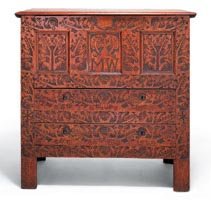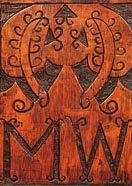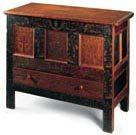A Mystery Revealed: Unraveling the Story of a Hadley Chest
 |
A Mystery Revealed: Unraveling the Story of a Hadley Chest
Rarely does furniture that has survived several centuries of daily use retain its original surface. Over time, furniture is often covered with linseed oil, turning gummy and dark and thereby obscuring the finish; painted surfaces are repainted due to flaking or changing tastes; or furniture is merely refinished. When an object does survive intact, its value is enhanced, both for reasons of rarity as well as its importance as a document of past finish treatments.
 | |
| Fig. 1: Hadley chest with the initials “MW.” Hatfield, Massachusetts, ca. 1707. White oak and pine. Courtesy, Shelburne Museum. |
What does one do when confronted with an object that no longer retains its original painted surface?1 Leave it alone? Repaint it? What is the process involved when making such a decision, realizing that each situation is unique? The Shelburne Museum, Shelburne, Vermont, was posed with just such a scenario, and this is the story of how it responded.
In the collection of the Shelburne Museum is a chest with drawers from western Massachusetts. Made in 1707, the chest is inscribed with the carved initials of the original owner, Martha Williams [Fig. 1]. This type of chest, with its distinctive mannerist-inspired tulip-and-oak-leaf carved façade, is known as a Hadley chest. Early collector Henry Wood Erving coined the term in 1883 when he found a similar example [Fig. 2] in a Hadley, Massachusetts, home.
 |  | |
| Left: Detail of the carved “MW” chest. Shelburne Museum; photography by Ted Curtin. Right: Fig. 1a: Detail of carving, “MW” chest. Shelburne Museum; photography by Ted Curtin. | ||
Martha Williams of Hatfield, Massachusetts, a neighboring town of Hadley, most likely received this chest as part of her dowry when she married Edward Partridge in1707. When she owned the chest it was more elaborate than it appears even now, for it was decorated with a painted surface long since removed, re-applied, and stripped again. How would the museum reinterpret this object that only partially represented what it once was?
 | |
| Fig. 2: Hadley chest with the initials “RD.” Hadley, Massachusetts, ca. 1700. Painted oak and pine. Courtesy, Chipstone Foundation. |
Shelburne Museum received a grant this past year to fund artisans to work before the public. As part of the program, Curator Jean Burks hired joiner Rob Tarule to make a copy of the “MW” chest. Together with museum conservator Nancie Ravenel, they would re-create the surface that had covered the original chest and interpret it on the reproduction. This is the perfect solution for a museum, as it retains the finish history of the original chest through its various stages; allows for future study and interpretation; and provides an opportunity to explore, re-create, and in the end present to the public sa decorative scheme considered fashionable in early-eighteenth-century Colonial America.
By what process does a curator determine original paint colors? Burks began by asking Ravenel to analyze the “MW” chest for any original paint residue. Jean then began tracking down related examples to either corroborate Ravenel’s findings or use as guides in re-creating the color scheme. What she thought would be a relatively simple task quickly became complicated. She eventually found two similar chests, both of which appeared to remarkably retain their original painted surfaces: one with the initials “RD” in the collection of the Chipstone Foundation, the other in a private collection carved with the initials “HN,” [Figs. 2, 3].
Tarule, a joiner who specializes in re-creating seventeenth- and early-eighteenth-century furniture, examined the construction techniques and carving of the “MW” chest. In comparing his findings with the “RD” and “HN” chests, he came to the exciting conclusion that all three were probably made in the same shop and carved by the same hand, possibly even using the same template [Fig. 1a]. Therefore, there may have been consistency of paint colors used among the three as well.
 | |
| Fig. 3: Hadley chest with the initials “HN.” Hadley/Hatfield Area, ca. 1700. Painted oak and pine. Colors analyzed by independent conservator Susan Buck. Courtesy, Leigh Keno American Antiques; private collection. |
What then was the original paint surface of the “MW” chest? In her analysis, Ravenel determined that the chest had originally been painted, but that there was insufficient evidence to suggest a color scheme. The team therefore decided to base the colors for the reproduction chest on the “HN” chest, which had been examined through microscopic analysis. The original colors found on this chest are quite startling, revealing a brilliant, but now darkened, Prussian blue, deep red, black, and white, which has yellowed with age. A visual analysis of the “RD” chest revealed the colors of Prussian blue and red.
The next step in this story is to determine which colors to apply to the “MW” chest and where to place them. Also the consistency of the paint needs to be assessed—should the paint obscure the wood below or should the rays of the wood show through? The team will now make these decisions, and once they have re-created their interpretation of the original decorative scheme, The Catalogue of Antiques & Fine Art will publish the results in a forthcoming issue.
1. If it is suspected that an object may retain an old surface, consult a conservator before undertaking any finish treatment.
Jean M. Burks is curator of decorative arts, Shelburne Museum, Shelburne, Vermont. She is the author of Birmingham Brass Candlesticks (1986) and the co-author, with Timothy Rieman, of The Complete Book of Shaker Furniture (1994). Rob Tarule is a joiner specializing in the techniques of early furniture craftsmen. He is on the faculty of Goddard College, Plainfield, Vermont, where he teaches history through traditional woodworking. Nancie Ravenel is associate conservator of objects, Shelburne Museum.
This article was originally published in Antiques & Fine Art magazine, a fully digitized version of which is available at www.afamag.com. AFA is affiliated with Incollect.com.
 |



























